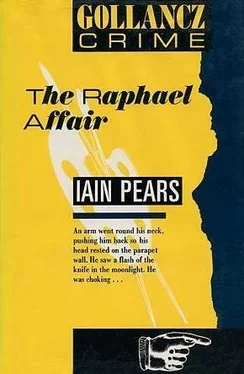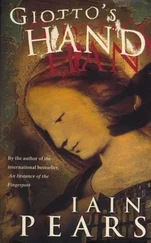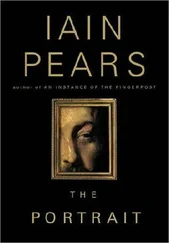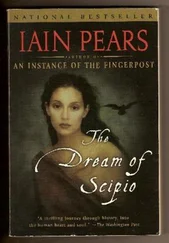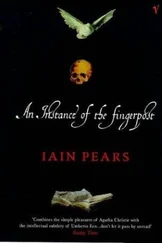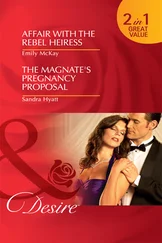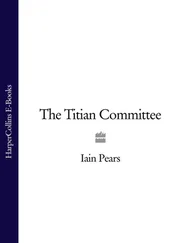Iain Pears - The Raphael Affair
Здесь есть возможность читать онлайн «Iain Pears - The Raphael Affair» — ознакомительный отрывок электронной книги совершенно бесплатно, а после прочтения отрывка купить полную версию. В некоторых случаях можно слушать аудио, скачать через торрент в формате fb2 и присутствует краткое содержание. Город: London, Год выпуска: 1990, ISBN: 1990, Издательство: Victor Gollancz, Жанр: Исторический детектив, на английском языке. Описание произведения, (предисловие) а так же отзывы посетителей доступны на портале библиотеки ЛибКат.
- Название:The Raphael Affair
- Автор:
- Издательство:Victor Gollancz
- Жанр:
- Год:1990
- Город:London
- ISBN:978-0-575-04727-3
- Рейтинг книги:3 / 5. Голосов: 1
-
Избранное:Добавить в избранное
- Отзывы:
-
Ваша оценка:
- 60
- 1
- 2
- 3
- 4
- 5
The Raphael Affair: краткое содержание, описание и аннотация
Предлагаем к чтению аннотацию, описание, краткое содержание или предисловие (зависит от того, что написал сам автор книги «The Raphael Affair»). Если вы не нашли необходимую информацию о книге — напишите в комментариях, мы постараемся отыскать её.
The Raphael Affair — читать онлайн ознакомительный отрывок
Ниже представлен текст книги, разбитый по страницам. Система сохранения места последней прочитанной страницы, позволяет с удобством читать онлайн бесплатно книгу «The Raphael Affair», без необходимости каждый раз заново искать на чём Вы остановились. Поставьте закладку, и сможете в любой момент перейти на страницу, на которой закончили чтение.
Интервал:
Закладка:
‘Just as well,’ thought Flavia, remembering the dry technocrat who had ruled supreme for years at the museum. ‘Without a spectrometer they couldn’t tell a Botticelli from a Chagall.’
She flipped through the pages of experiments and began on the conclusion, on the safe assumption that whatever the main body of the text contained would be duplicated in simpler language at the end.
The examiners had begun by looking at the canvas. This, they said, consisted of threads of varying width with irregular weaving, consistent with the canvases used in the late fifteenth century. The stretch-marks indicated that the canvas had not been cut down or stretched on to a new frame, and the wooden frame itself, made of poplar, also appeared to be of an appropriate age. A carbon-fibre dating of the canvas and the paint — done by snipping a minuscule fragment off the side, grinding it down and dosing it with radioactivity — indicated that it was not less than three hundred and fifty years old.
‘Before 1600, more or less. Pre-Mantini, in other words,’ she noted. So far the picture was holding up well.
The experts had then moved on to the paintwork itself, noting that as the picture had been covered over for more than two hundred years and had been cleaned and restored before examination, there were particular difficulties. They also noted that they had been instructed to keep any paint removed for analysis to the absolute minimum, and come from as near to the edges as possible. However, the report continued that, despite these strictures, they were able to complete a fairly full examination of the different colours used and of the techniques employed in painting.
Again, the portrait came through. The craquelure, the hairline cracks that appear in old oil paintings as they age and grow brittle, were irregular; artificially induced cracks generally ran parallel as a forger rolled the picture up to give a false impression of age. The remains of dirt in the cracks — most had been cleaned out — were composed of different substances while forgeries generally contained some homogeneous material, such as ink, used to give the impression of dirt.
All the paints were of raw materials used in the sixteenth century and X-ray examination, conducted at different electricity levels to build up a three-dimensional picture down through the paint, suggested that it had been painted according to techniques used in other Raphael works.
The final summary was as definite as any scientist was likely to be. Under examination and bearing in mind the limitations mentioned, the painting was consistent with a work produced at the start of the sixteenth century by a painter using techniques also employed in several of Raphael’s works. The lengthy footnote, with citations, detailed the virtual impossibility of reproducing such characteristics in a modern picture. Of course, judgement was reserved on whether it actually was by Raphael, but there was not a shred of evidence to suggest that it was not. The report was dated and signed by all five members of the investigating team.
Flavia put the folder down, rubbed her eyes and stretched herself. That, certainly, seemed to nobble Argyll’s suspicions. She turned her attention to the mound of mail that had built up on her desk while she was reading, and started methodically but absent-mindedly to transfer most of the envelopes to the desk of the temporarily absent Paolo. Her work was, perhaps, thirty per cent enjoyable and seventy per cent dull and routine. Running around interviewing people, tracing pictures, keeping up contacts among dealers, auctioneers and collectors was the fun part. Reading reports, checking journals and filling out the innumerable forms that the polizia considered a vital aspect of good security work was very much less so. A nice, juicy scandal would have tipped the balance more towards the entertaining end. Pity.
7
Any lingering regret on the subject of Elisabetta in Flavia’s mind had only until 10.37 the following Thursday to germinate before being consigned to the distant past.
She knew that it was exactly 10.37, because that was the time stamp that the ancient telex machine in the office placed at the end of the message from the French police saying that the case of the icon-stealing tourist had reached a conclusion, albeit not a very satisfactory one. The message from Paris read that Jean-Luc Morneau, connoisseur, aesthete, painter, dealer and suspected criminal, had been found. Unfortunately, he was dead, and so was likely to be of little use in helping the police with their enquiries.
The French were quite proud of their discovery although, as Bottando observed, they appeared to have no idea where all the icons had gone. The fact that Morneau had clearly died of a heart attack, brought on, so the Parisians said discreetly, by excess exertion, lessened Bottando’s interest. Especially as there was a witness to both the exertions and the demise, and the graphic details provided by the young woman involved were convincing enough to rule out foul play. Bottando was not greatly concerned in the matter, as he had long since given up hope that any of the missing Italian icons would ever be discovered. But, for the sake of thoroughness, he asked the French to keep his department informed about any new developments.
In due course, the French ran the dealer’s old mistress to earth. In return for their agreeing to ignore the state of her income-tax payments, she told them that Morneau had rented a safe deposit box in a Swiss bank. A bit of gentle arm-twisting of opposite numbers in Zurich produced a grudging permission to look inside it, and Bottando was invited to come along to the grand opening.
Six weeks to the day after Morneau’s body was discovered, therefore, Bottando and Flavia flew into Zurich airport, where they were met by an official police car and driven swiftly into the financial heart of the city. As usual, Bottando had wanted to stay in Rome and grumbled incessantly during the flight. If he disliked travelling, he disliked travelling to Switzerland even more. The cleanliness, order and efficiency of the place profoundly upset him and he also found the Swiss insufferable, not least because of his utter failure to persuade them to do anything to stop the steady flow of smuggled art works over the Italian/Swiss border.
The only thing that persuaded him to get on the plane, in fact, was the realisation that it was an ideal excuse for not going to yet another of Tommaso’s parties in the museum. Its purpose was uncertain, but the man had said something about fund raising and was insisting that all members of the Security Committee, as it was now grandly termed, were present. Bottando took considerable pleasure in ringing up, presenting his apologies, and pleading pressing police business.
Tommaso had not been happy. He was angling for a large donation, he said, and really needed Bottando there to impress the potential benefactors. It was only when Bottando explained, with some exaggeration, that he needed to go to Switzerland and had high hopes of recovering some invaluable icons, that the man gave way.
He did it, at least, with some grace. If Bottando could recover any part of the Italian heritage, then that must take precedence, he said somewhat pompously. The General should not even consider coming to the party. They would manage without him, and Spello would be there to answer any questions about museum security.
So he’d gone, and had slowly begun to wonder whether the museum folk were worse than the Swiss police, or the other way around. Attempts at international conversation as the large black Mercedes whistled down the autobahn were accordingly muted, and the atmosphere did not thaw until Bottando spotted his long-time French equivalent in the bank lobby.
Читать дальшеИнтервал:
Закладка:
Похожие книги на «The Raphael Affair»
Представляем Вашему вниманию похожие книги на «The Raphael Affair» списком для выбора. Мы отобрали схожую по названию и смыслу литературу в надежде предоставить читателям больше вариантов отыскать новые, интересные, ещё непрочитанные произведения.
Обсуждение, отзывы о книге «The Raphael Affair» и просто собственные мнения читателей. Оставьте ваши комментарии, напишите, что Вы думаете о произведении, его смысле или главных героях. Укажите что конкретно понравилось, а что нет, и почему Вы так считаете.
